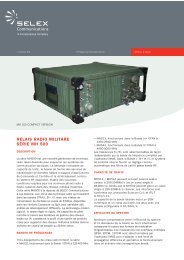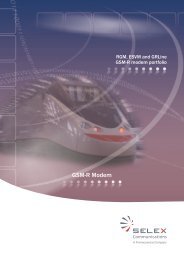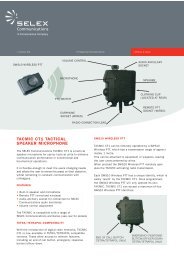LOAM LASER OBSTACLE AVOIDANCE SYSTEM
LOAM LASER OBSTACLE AVOIDANCE SYSTEM
LOAM LASER OBSTACLE AVOIDANCE SYSTEM
Create successful ePaper yourself
Turn your PDF publications into a flip-book with our unique Google optimized e-Paper software.
<strong>LOAM</strong> <strong>LASER</strong> <strong>OBSTACLE</strong> <strong>AVOIDANCE</strong> <strong>SYSTEM</strong><br />
>Professional Communications > Telecom Operators > Military & Space > Avionics CNI<br />
<strong>LOAM</strong><br />
<strong>LASER</strong> <strong>OBSTACLE</strong> <strong>AVOIDANCE</strong> <strong>SYSTEM</strong><br />
DESCRIPTION<br />
The <strong>LOAM</strong> is a state-of-the-art “navigational aid system”<br />
for rotary wing platforms specifically designed to detect<br />
potentially dangerous obstacles placed in or nearby the<br />
flight path and to warn the crew in sufficient time to<br />
implement effective avoiding maneuvers.<br />
The <strong>LOAM</strong> works on the “laser radar” principle using an<br />
eye-safe laser. A laser beam periodically scans the area<br />
around the flight path and on the basis of the returned echo<br />
analysis, using an innovative software algorithm, it identifies<br />
possible obstacles and provides the crew with the relevant<br />
information and warnings.<br />
As opposed to radar, the use of a laser beam, instead of an<br />
RF emission, for the scan offers the following, remarkable<br />
advantages:<br />
> achievement of sufficient return power even for obstacles<br />
with non-perpendicular incidence;<br />
> use of a very narrow scan beam leading to a high<br />
resolution system.<br />
The <strong>LOAM</strong> is capable of classifying the following classes of<br />
obstacle:<br />
> Wire. Thin obstacles such as, telephone cables, electrical<br />
cables (up to 5 mm diameter whether electrified or not).<br />
> Tree. Vertical obstacles such as, trees, poles and pylons.<br />
> Structure. Extended obstacles such as, bridges,<br />
buildings and hills.<br />
Obstacle detection is achieved by the following, sequential,<br />
functional processes: laser scan, echo detection and<br />
detected echo analysis.<br />
The <strong>LOAM</strong> periodically scans with a laser beam the area<br />
around the flight path within the system’s field of view.<br />
The <strong>LOAM</strong> performs echo detection through an analogue<br />
process comprising optical-electrical conversion, signal<br />
pre-amplification and threshold comparison. The signal<br />
pre-amplification is achieved by an automatic gain<br />
controlled amplifier that increases system sensitivity as the<br />
elapsed time from the laser emission<br />
increases to allow for lower return signal power from more<br />
distant obstacles. Furthermore, the threshold level may be<br />
adjusted to compensate for background conditions. All the<br />
above leads to:<br />
> Elimination of the probability of false echo detection due<br />
to atmospheric back-scatter near the laser beam output;<br />
> Optimisation of system sensitivity for every operational<br />
atmospheric condition.<br />
The <strong>LOAM</strong> performs echo analysis to determine the<br />
presence of possible obstacles and to determine their<br />
geometrical characteristics and position. To do this,<br />
the <strong>LOAM</strong> employs two sequential analysis processes:<br />
1. local analysis;<br />
2. global analysis.<br />
The “local analysis” process analyses the single echoes in<br />
order to determine range, angular co-ordinates and characteristics<br />
of the obstacle portion generating them.
<strong>LOAM</strong> <strong>LASER</strong> <strong>OBSTACLE</strong> <strong>AVOIDANCE</strong> <strong>SYSTEM</strong><br />
<strong>LOAM</strong><br />
Laser Obstacle Avoidance System<br />
MAIN FEATURES<br />
> Employs an eye-safe laser<br />
> Identifies and classifies dangerous obstacles<br />
> High angular and range resolution<br />
> Uses on-board or own display<br />
> Very low false alarm rate<br />
> Activates audio warning<br />
> Communicates with other systems
<strong>LOAM</strong> <strong>LASER</strong> <strong>OBSTACLE</strong> <strong>AVOIDANCE</strong> <strong>SYSTEM</strong><br />
TECHNICAL CHARACTERISTICS<br />
General characteristics<br />
Horizontal FOV 40°<br />
Vertical FOV 30°<br />
FOV Steering<br />
Max. Detection Range<br />
Min. Detection Range<br />
± 20° both in horizontal and in vertical<br />
2000 m<br />
50 m<br />
Obstacle Detection Probability > 99.5 %<br />
False Alarm Rate<br />
< 1 per 2 hours<br />
Qualified according to<br />
MIL STD 810E and MIL STD 461C<br />
Electrical Interface<br />
EIA RS422 and MIL-STD-1553B<br />
Power Supply +28 VDC, < 300 W (MIL STD 704E)<br />
Eye-safe laser according to STANAG 3606 LAS class I<br />
Sensor head unit<br />
Dimension<br />
Weight<br />
320 x 239 x 419 mm<br />
24 kg<br />
Control panel unit<br />
Dimension<br />
Weight<br />
146 x 38,1 x 155 mm<br />
0.5 kg<br />
Warning unit<br />
Dimension<br />
Weight<br />
110.2 x 25.4 x 75 mm<br />
0.35 kg<br />
Display unit<br />
Dimensions<br />
Weight<br />
4 x 5 ATI<br />
1,7 kg
SELEX Communications<br />
e-mail: info@selex-comms.com<br />
www.selex-comms.com<br />
This publication is issued to provide outline information only which (unless agreed by SELEX<br />
Communications S.p.A. in writing) may not be used, applied or reproduced for any purpose<br />
or form part of any order or contract or be regarded as a representation relating to the<br />
products or services concerned. SELEX Communications S.p.A. reserves the right to alter<br />
without notice the specification, design or conditions of supply of any product or service.<br />
SELEX Communications logo is a trademark of SELEX Communications S.p.A.<br />
Printed in Italy.<br />
© SELEX Communications S.p.A. All Rights reserved.<br />
CODE e-A-IT-015/V1/05/X


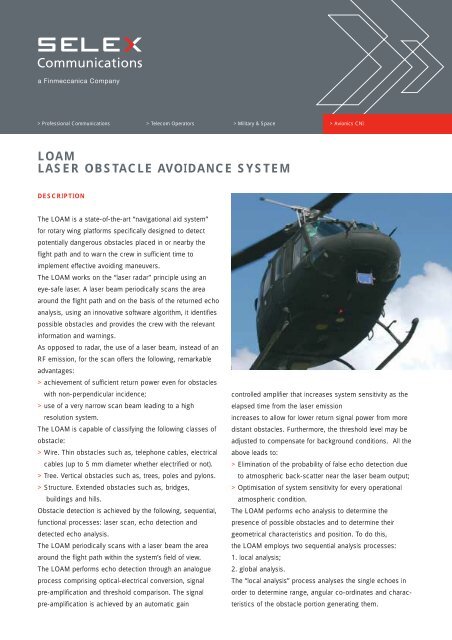
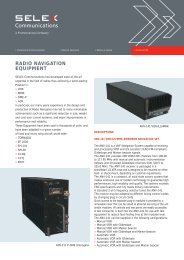




![ENG [PERSEUS] WiNNMobile-V2_1111NL.FH11](https://img.yumpu.com/45232555/1/184x260/eng-perseus-winnmobile-v2-1111nlfh11.jpg?quality=85)



